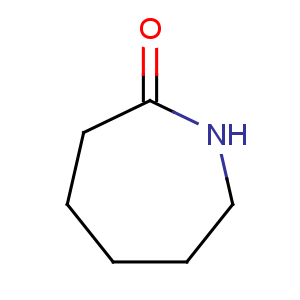Title: Caprolactam
CAS Registry Number: 105-60-2
CAS Name: Hexahydro-2
H-azepin-2-one
Synonyms: e-caprolactam; 2-oxohexamethylenimine; 2-ketohexamethylenimine; aminocaproic lactam
Molecular Formula: C6H11NO
Molecular Weight: 113.16
Percent Composition: C 63.68%, H 9.80%, N 12.38%, O 14.14%
Literature References: Prepn: Wallach,
Ann. 312, 187 (1900);
343, 43 (1905); Ruzicka
et al., Helv. Chim. Acta 4, 477 (1921); Eck, Marvel,
J. Biol. Chem. 106, 387 (1934); Marvel, Eck,
Org. Synth. coll. vol. II, 371 (1943); Lazier, Rigby,
US 2234566 (1941 to du Pont); Schlack,
US 2249177 (1941 to I. G. Farben);
DE 739953 (1943);
DE 745224 (1943); P. Smith,
J. Am. Chem. Soc. 70, 320 (1948); E. Schmitz
et al., J. Prakt. Chem. 319, 274 (1977). Environmentally benign synthesis from cyclohexanone: J. M. Thomas, R. Raja,
Proc. Natl. Acad. Sci. USA 102, 13732 (2005). Purification: Kampschmidt,
US 2786052 (1957 to Stamicarbon N. V.). Stabilization with alkalies: Indest
et al., US 2884414 (1959 to Vereinigte Glanzstoff-Fabriken). Toxicity study: H. F. Smyth
et al., Am. Ind. Hyg. Assoc. J. 30, 470 (1969).
Reviews: CIOS Repts. no.
22 and
31, File XXXIII/Synthetic Fiber Developments in Germany, parts I & II; K. Kahr
et al. in
Ullmanns Encyklop?die der technischen Chemie vol. 9, E. Bartholome
et al., Eds. (Verlag Chemie, Weinheim, 4th ed., 1975) pp 96-114.
Properties: Hygroscopic leaflets from petr ether, mp 70°. d475 (liq) 1.02. bp50 180°; bp3 100°. Viscosity (78°): 9 cP. Flash pt, open cup: 257°F (125°C). Freely sol in water, methanol, ethanol, ether, tetrahydrofurfuryl alcohol, dimethylformamide. Also sol in chlorinated hydrocarbons, cyclohexene, petroleum fractions. A 70% aq soln has d425 1.05;
nD31 1.4965;
nD40 1.4935. LD50 orally in rats: 2.14 g/kg (Smyth).
Melting point: mp 70°
Boiling point: bp50 180°; bp3 100°
Flash point: Flash pt, open cup: 257°F (125°C)
Index of refraction: nD31 1.4965;
nD40 1.4935
Density: d475 (liq) 1.02; d425 1.05
Toxicity data: LD50 orally in rats: 2.14 g/kg (Smyth)
CAUTION: Potential symptoms of overexposure are irritation of eyes, skin, respiratory system; epistaxis; dermatitis, skin sensitization; asthma; irritability, confusion, dizziness, headache; abdominal cramps, diarrhea, nausea, vomiting; liver and kidney injury.
See NIOSH Pocket Guide to Chemical Hazards (DHHS/NIOSH 97-140, 1997) p 50.
Use: Manuf of synthetic fibers of the polyamide type (Perlon); solvent for high mol wt polymers; precursor of nylon-6,
q.v.

